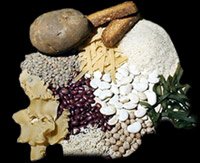Carbohydrates have been receiving a lot of attention in recent years due to the popularity of Low Carbohydrate Fad diets. The key word being FAD! Please, just as a note, if any of you or your loved ones are thinking of doing a low to no carbohydrate diet in the hopes of losing fat, Read this first!
The following article will change how many of you look at Carbohydrates. Once you understand how carbs work in your body, you can maximize energy and yes loose fat while taking in a fairly high carbohydrate diet.

What Are Carbohydrates?

Carbohydrates are everything from sugars to pasta and breads. The one thing all carbohydrates have in common, is they are all composed of one of three monosaccharides, (Mono = One, Saccharide = Sugar). These three monosaccharides are Glucose (dextrose), Fructose (levulose or fruit sugar), and Galactose. All of these three molecules are composed of Carbon, Hydrogen and Oxygen. They all have different shapes, and these different shapes give each sugar its unique properties such as taste.
Glucose
- - Glucose has a chemical composition of 6 carbons, 12 hydrogen, and 6 Oxygen. This is the only sugar that affects blood sugar. Glucose, when present in excess in the bloodstream is stored in the muscles as Glycogen. Glycogen is just a big string of glucose molecules. I'll touch on this more later on.
Fructose - Fructose has the same chemical composition of Glucose, however has a different shape. This different shape means it reacts with your body differently. Fructose is the sweetest tasting of the three simple sugars. It is absorbed into the bloodstream, however does not affect blood sugar levels. Remember that only Glucose affects blood sugar levels.
Fructose, when absorbed into the blood is taken to the liver, and broken down into its 6 Carbons, 12 Hydrogen's, and 6 Oxygen's, and re-formed into a glucose molecule. It is then and only then that the former fructose molecule is released into the bloodstream. Because it is now in the form of glucose, it does have an effect on blood sugars, and can be stored in muscle cells as glycogen.
Galactose - Galactose again has the same chemical composition of Glucose; however this sugar is only present in Milk. Galactoses, along with glucose form the sugar in milk, Lactose, which is a disaccharide.
Disaccharides are two simple sugars bonded together. Like the monosaccharides, there are three Disaccharides; Sucrose, Lactose, and Maltose.
- Sucrose = Glucose + Fructose
- Lactose = Glucose + Galactose
- Maltose = Glucose + Glucose
 Beyond this there are numerous combinations of simple sugars. Anything larger than a disaccharide, but smaller than 6 monosaccharides, is known as an oligosaccharides. These are only faintly sweet, and are also known as maltodextrins.
Beyond this there are numerous combinations of simple sugars. Anything larger than a disaccharide, but smaller than 6 monosaccharides, is known as an oligosaccharides. These are only faintly sweet, and are also known as maltodextrins.
Polysaccharides are starches. Starches are long chains of sugar molecules joined together like the beads on a string of pearls. Starch is the plants version of Glycogen. It is not sweet tasting at all. (Think of a potato.)
Fibers
Dietary fibers are large carbohydrate molecules containing many different sorts of monosaccharides. The key difference between fiber and other carbohydrates is that they are not broken down by the human digestive system. Fibers will remain unchanged until they reach the large intestine.
There Are Two Types Of Fiber:
- Soluble
- Insoluble
Soluble fibers can be dissolved in water. (Hence the name) These fibers are beneficial in that they can slow the speed of digestion due to their thickness.
Insoluble fibers are such things as cellulose and are insoluble in water. Fruits are an example of a source of soluble fibers, and vegetables are a source of insoluble fibers. Insoluble fibers do not affect the speed of digestion.

Digestion Of Carbohydrates

To absorb the nutrients from the food we eat, food must be broken down into a form we can absorb through our intestine walls. The process of digestion starts in the mouth with an enzyme called amylase. Amylase is present in the saliva and begins the breakdown of long chain starch molecules into shorter chain molecules (maltodextrins). This digestion however stops due to the acids in the stomach.
The stomach acids denature or destroy amylase. This is where the food swallowed is broken down further, but only in the physical sense. The food is only broken into smaller pieces. It is not until these smaller pieces reach the small intestine where the chemical breakdown continues. This is where fiber can come into play. As I said above, fiber can delay food from emptying into the small intestine.
This Has Two Benefits:
- Number one, any carbohydrate digestion to be done in the small intestine is delayed.
- Number two; it gives you the feeling of satiety, or satisfaction from a meal.
In the small intestine, huge amounts (more than needed) of amylase are secreted and go to work on breaking down the carbohydrates. This is where speed of absorption depends on the kind of starch. The larger the molecule, the longer it will take to break down, and therefore to be absorbed into the blood.

A Quick Note On Energy Systems

Your body burns Alcohol, Protein, Carbohydrates and Fat, in that order. Because there is no place to store alcohol in your system, it is used first. The fuel our body uses is almost always a mix of carbohydrates and fat. The mixture depends on your insulin levels.
 Insulin when in the blood stream basically causes your body to store glucose as glycogen. If insulin levels are low, meaning, you haven't consumed a meal high in carbohydrates in some time (ex. First thing in the morning) than the fuel mix is primarily fat. On the other hand, following a large carbohydrate meal, Insulin levels are high, and the mix is primarily Carbohydrates.
Insulin when in the blood stream basically causes your body to store glucose as glycogen. If insulin levels are low, meaning, you haven't consumed a meal high in carbohydrates in some time (ex. First thing in the morning) than the fuel mix is primarily fat. On the other hand, following a large carbohydrate meal, Insulin levels are high, and the mix is primarily Carbohydrates.
Insulin also has a role in the storage of free fatty acids as body fat. So, what we can take from all of this is that, if we keep our insulin levels low, than we will end up with a fuel mix of primarily fat. Now, the big question is HOW do we keep insulin levels lowered?
To answer this question we must look at the TYPE of carbohydrate. This doesn't mean simple and complex carbs, as many people still think. This is where we will meet your new best friend. It's called the Glycemic Index. Get to know each other; I'll help with the introduction.

The Glycemic Index

The glycemic index is one of the most important aspects to consider when deciding what carbohydrates to incorporate into your diet. What it is, is every food (carbohydrate) is given a rating. This rating is related to its effect on spiking your blood sugar.
This is important because when your blood sugar spikes, your pancreas secretes the hormone insulin to shuttle this glucose from your blood into your body cells. The glycemic index is based on a base value of glucose. Glucose, which can be almost immediately absorbed into your blood, is given a value of 100. Values of other foods are based on their comparison to glucose.
For example, if a low glycemic index carbohydrate is consumed, (for example a Glycemic index of 70) it means it is absorbed present in the blood about 30% slower than glucose is. This is important because, with the slower absorption comes less of an insulin spike.
This, again means, your body relies more on fat than carbs for everyday energy activities. As well, the slower the carbohydrate is absorbed, the easier time your body has of storing it, and the more energy will be stored in your muscle cells.

Weight Loss

If you are looking to loose weight and keep the carbs in your diet, the best idea is to consume low to moderate glycemic index carbohydrates, therefore, avoiding an insulin spike. One disadvantage to having an insulin spike due to a high glycemic index carbohydrate is overeating.
Have you ever noticed when you are at the movies and you have just a small handful of candy, you are fine for about 10 to 20 minutes, but then you just can't help but have more. The reason behind this is that when you first consume the high sugar candy, your body absorbs it and blood sugar levels are raised. In response to this your body triggers the pancreas to release insulin.
This insulin spike, because it is so rapid, is often a little too much. What this means is your blood sugar levels drop slightly below what they were before eating the candy. When your body senses the low blood sugar, it releases hormones which trigger hunger. It is your body's way of controlling the blood sugar. If insulin levels are too low, it triggers hunger, and you eat, raising them up, if it is too high, you feel somewhat satisfied, not eating, giving your body a chance to store the blood sugar as muscle glycogen.
Remember just because a food has a low GI value, you must also take into consideration the amount or grams of carbohydrate being consumed. Here's something to think about; In Asia, the base of the population's diet is rice and grains (Carbohydrates, moderate to low glycemic index).
In Asia, obesity is virtually non existent. Here in North America, where the trend is either low carbohydrate diets, or an extremely high sugar, high protein diet, obesity is an epidemic. Now I know that there are a lot more factors to think about when making a statement like that, but it is something to think about.
Why has this only recently become a problem? Why haven't we seen obesity problems in early years of history? The answer to this is that in previous years, the population primarily consumed lower glycemic index carbohydrates. There was no sugar pops, or pop tarts, or frosted flakes. Ask your grandparents what they ate on a regular basis and I bet the majority of them had a base diet of low glycemic index carbohydrates.

Carbohydrates & Athletic Performance

 For Athletes seeking peak performance in events, (such as a bodybuilder seeking a kick ass workout) there are times when you need low glycemic index carbohydrates (such as before a workout) and times when a high glycemic index carbohydrate is beneficial (immediately after and even during a workout). It is important to note that for this strategy to work, the overall consumption of carbohydrates must be high.
For Athletes seeking peak performance in events, (such as a bodybuilder seeking a kick ass workout) there are times when you need low glycemic index carbohydrates (such as before a workout) and times when a high glycemic index carbohydrate is beneficial (immediately after and even during a workout). It is important to note that for this strategy to work, the overall consumption of carbohydrates must be high.
(We are assuming this is during a mass gaining period for bodybuilders).
As I mentioned before, carbohydrates are broken down into simple sugars, absorbed into the blood, and stored in the muscle cells in the form of glycogen. This glycogen is then broken down as needed to provide energy for working muscles. If carbohydrate amounts are low, there is not the maximum storage of glycogen in the body (approximately 500 grams for the average person).
Not having enough total carbohydrate consumption will lead to a shortage in energy during exercise requiring glycogen due to a reduced amount being stored. Simply put, if you don't provide your body with enough carbs, not enough will be stored and there will be a shortage during exercise. Almost all glycogen stores are used up after about two hours of strenuous exercise. This is called hitting the wall. When all things are equal in a race, or activity, involving strenuous exercise, it will come down to who has the highest glycogen stores.
Low GI foods have been proven to extend endurance when eaten alone one to two hours before an activity. Scientists compared cyclists performance after eating the same amount of carbohydrates, one group eating lentils (a low GI food) and the other eating potatoes (a high GI food). Both groups cycled at the same intensity however the group that had eaten the lentils was able to maintain this intensity for 20 minutes longer than the potato group. Several other studies have confirmed these results.
You may be asking, how the time to exhaustion of cyclists applies to my workout. Well, it does and it doesn't. The benefits of consuming a low GI food before a workout will only be seen in strenuous events lasting around 90 minutes. If you are in the gym longer than 90 minutes, or as many of you reading this may be athletes involved in sports such as swimming, soccer, marathons, or triathlons, using low GI foods will benefit you.
If you are a bodybuilder, using low GI foods will not directly have an effect on your workout because your body uses a different energy system to power heavy lifting (involves primarily creatine phosphate). However, using high GI foods after your workout will benefit you by replacing lost energy immediately after a workout.
Another time when using high GI foods will benefit bodybuilders is when taking creatine. Because insulin stimulates the storage of energy systems into body cells, having high insulin levels when taking creatine has been proven to cause a higher absorption of creatine into muscle cells. This is why Cell Tech is creatine mixed with dextrose. (dextrose is another name for glucose, which has a GI value of 100)
Another benefit to knowing about the GI is during Carbohydrate Super compensation diets. Due to the shape of the glycogen molecule, each gram of glycogen is stored with approximately 3 grams of water. As a result muscle cells become fuller when packed with glycogen due to the ensuing water absorption.
When you go through a carbohydrate depletion phase you increase the amount of GLUT 4 receptors, which are just simply the receptors that pull glucose into the cell from the bloodstream. With the increased GLUT 4 receptors, the body is able to pull more glucose into the cell and store it as glycogen. This "super compensation" of glycogen fills the muscle cell with more water than usual, giving your muscles a fuller look onstage.

Why Low Carbohydrate Diets Are Dangerous

Depriving your body of carbohydrates will force your body to go to muscle and fat as energy. Depending on what you are doing, your body will go to muscle tissue when energy is needed immediately, such as High intensity exercise lasting less than 2-3 minutes.
Lower intensity activity, basically, walking, will use primarily fat, however, instead of using carbohydrates as in someone consuming carbohydrates in their diet, your body is forced to use muscle tissue as the secondary ingredient in the fuel mix. This translates to a lot of muscle tissue being broken down to provide energy. More importantly, in low carbohydrate diets you make up for the lost carbohydrate calories by increasing your fat and protein intake.
This increased fat intake can put your cholesterol levels, LDL (low density lipoproteins) levels up through the roof. All in all this translates to a loss in muscle tissue and an increased risk of cardiovascular disease.
Here's why:
Your body stores approximately 500 grams of glycogen. When no carbohydrates are taken in, these stores are used up to supply energy in the fuel mix. So, just in glycogen, she's lost a half a pound. Good job Edna! But Wait… remember earlier we learned that each gram of glycogen is stored with up to five grams of water (I've read everything from 2.3 grams of water/gram of glycogen, to up to five grams of water/gram of glycogen).
For these purposes we'll assume it's five grams of water per gram of glycogen. So with the loss of 500 grams of glycogen goes 2500 grams of water. When Edna stood on the scale she must have been thrilled to have lost three pounds of water and glycogen. The additional for would come from a mix of primarily muscle tissue and a minimal amount of fat.

Conclusion

With a broad knowledge of what carbohydrates are and how they work, you can increase performance, maximize weight loss without loosing the energy, improve overall health and maximize energy stores. Be smart with what you read. Exercise and diet is a science and like other sciences it is constantly changing. Use your brain when reading material.
Check to see if it is put out by someone who will directly benefit by you following their advice. And if it sounds too good to be true, it most probably is. Again, if you have any questions or comments let me know via email with the subject of 'bodybuilding question'. Until next time, stay big, stay hard, and remember… IT'S NOT A GAME!
Best of luck,
